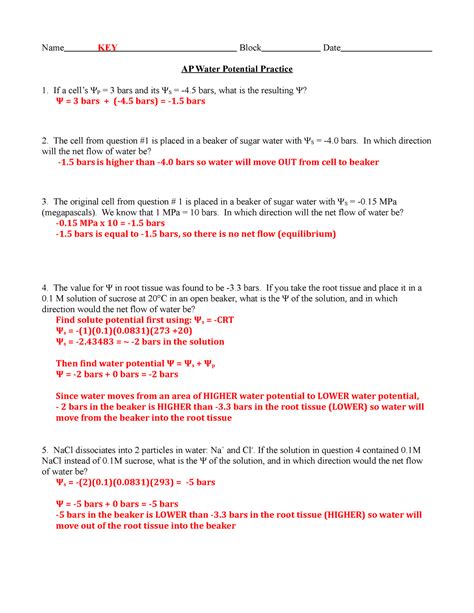Introduction
Water potential is a crucial concept in understanding water movement in plants, soil, and the environment. By solving practice problems, you can strengthen your grasp of this important topic. This article presents a comprehensive collection of water potential practice problems, ranging from basic to advanced levels, to help you hone your skills and prepare for future challenges.

Levels of Organization
Osmosis
Problem:
Pure water is separated from a 1.0 M sucrose solution by a semipermeable membrane. What is the water potential of each solution, and in which direction will water move?
Solution:
* Water potential of pure water: 0 MPa
* Water potential of 1.0 M sucrose solution: -2.46 MPa (calculated using the van’t Hoff equation)
* Water will move from pure water to the sucrose solution (from higher water potential to lower water potential).
Plant Cells
Problem:
A plant cell is placed in a solution with a water potential of -0.5 MPa. The cell’s cytoplasm has a water potential of -0.2 MPa. Will the cell gain or lose water?
Solution:
* Since the water potential of the solution is lower than that of the cytoplasm, the cell will lose water by osmosis.
Plant Tissues
Problem:
The root of a plant is exposed to a soil solution with a water potential of -0.1 MPa. The shoot of the same plant is exposed to air with a relative humidity of 50%. Calculate the water potential of the soil solution and shoot tissue.
Solution:
* Water potential of soil solution: -0.1 MPa
* Water potential of shoot tissue: -0.05 MPa (calculated using the relative humidity and temperature)
* Water will move from the soil solution to the shoot tissue (from higher water potential to lower water potential).
Ecosystem Water Balance
Problem:
A forest ecosystem has an annual precipitation of 1,000 mm and an annual evapotranspiration of 750 mm. What is the net water balance of the ecosystem?
Solution:
* Net water balance = Precipitation – Evapotranspiration
* Net water balance = 1,000 mm – 750 mm
* Net water balance = 250 mm
Applications
Water potential concepts have numerous applications in various fields, including:
Agriculture
- Optimizing irrigation schedules to maximize crop yield
- Reducing water loss in arid and semi-arid regions
Environmental Science
- Understanding the movement of water in aquifers and groundwater systems
- Assessing the impact of climate change on water resources
Biotechnology
- Developing new methods for desalination and water purification
- Enhancing plant drought tolerance
Effective Strategies
To effectively solve water potential practice problems, consider the following strategies:
- Understand the basic principles of water potential and osmotic pressure.
- Convert between different units of water potential (e.g., MPa, atm, bars).
- Use the appropriate equations and formulas for different scenarios (e.g., van’t Hoff equation, Ohm’s law).
- Draw diagrams and visualize the movement of water in response to water potential gradients.
Pros and Cons of Different Techniques
| Technique | Pros | Cons |
|---|---|---|
| Osmosis | Simple and efficient | Does not account for water movement due to pressure differences |
| Tensiometry | Measures water potential directly | Can be influenced by soil texture and temperature |
| Psychrometry | Measures relative humidity of air | Can be affected by temperature and air movement |
| Soil moisture sensors | Continuous monitoring of soil water potential | Can be expensive and prone to calibration issues |
Frequently Asked Questions
1. What is the difference between water potential and osmotic potential?
* Water potential is the measure of the potential energy of water, while osmotic potential is the component of water potential due to dissolved solutes.
2. How does temperature affect water potential?
* Temperature increases water potential.
3. Can water move from a lower water potential to a higher water potential?
* No, water cannot move spontaneously from a lower water potential to a higher water potential.
4. What is the role of water potential in plant growth?
* Water potential drives water uptake and transport within plants, which is essential for photosynthesis, nutrient uptake, and growth.
5. How can we measure water potential?
* Water potential can be measured using various techniques, including psychrometry, tensiometry, and soil moisture sensors.
6. What is the practical significance of water potential in agriculture?
* Water potential can be used to determine the timing and amount of irrigation required for optimal crop production.
7. How does water potential relate to solute concentration?
* The water potential of a solution decreases with increasing solute concentration.
8. What is the importance of water potential in environmental science?
* Water potential is essential for understanding groundwater flow, water quality, and the impacts of climate change on water resources.
